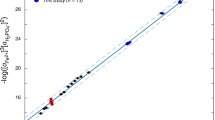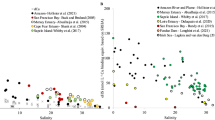Abstract
Uranyl (UO22+), the predominant aerobic form of uranium, is present in the ocean at a concentration of ~3.2 parts per 109 (13.7 nM); however, the successful enrichment of uranyl from this vast resource has been limited by the high concentrations of metal ions of similar size and charge, which makes it difficult to design a binding motif that is selective for uranyl. Here we report the design and rational development of a uranyl-binding protein using a computational screening process in the initial search for potential uranyl-binding sites. The engineered protein is thermally stable and offers very high affinity and selectivity for uranyl with a Kd of 7.4 femtomolar (fM) and >10,000-fold selectivity over other metal ions. We also demonstrated that the uranyl-binding protein can repeatedly sequester 30–60% of the uranyl in synthetic sea water. The chemical strategy employed here may be applied to engineer other selective metal-binding proteins for biotechnology and remediation applications.
This is a preview of subscription content, access via your institution
Access options
Subscribe to this journal
Receive 12 print issues and online access
$259.00 per year
only $21.58 per issue
Buy this article
- Purchase on Springer Link
- Instant access to full article PDF
Prices may be subject to local taxes which are calculated during checkout





Similar content being viewed by others
References
Nozaki, Y. A fresh look at element distribution in the North Pacific. Eos Trans. Am. Geophys. Union 78, 221–227 (1997).
Tabushi, I., Kobuke, Y. & Nishiya, T. Extraction of uranium from seawater by polymer-bound macrocyclic hexaketone. Nature 280, 665–666 (1979).
Kanno, M. Present status of study on extraction of uranium from sea water. J. Nucl. Sci. Technol. 21, 1–9 (1984).
Egawa, H., Nonaka, T. & Nakayama, M. Recovery of uranium from seawater. 7. Concentration and separation of uranium in acidic eluate. Ind. Eng. Chem. Res. 29, 2273–2277 (1990).
Sather, A. C., Berryman, O. B., Ajami, D. & Rebek, J. Jr Selective recognition and extraction of the uranyl ion. J. Am. Chem. Soc. 132, 13572–13574 (2010).
Franczyk, T. S., Czerwinski, K. R. & Raymond, K. N. Stereognostic coordination chemistry. 1. The design and synthesis of chelators for the uranyl ion. J. Am. Chem. Soc. 114, 8138–8146 (1992).
Gordon, A. E., Xu, J., Raymond, K. N. & Durbin, P. Rational design of sequestering agents for plutonium and other actinides. Chem. Rev. 103, 4207–4282 (2003).
Gong, H. Y., Rambo, B. M., Karnas, E., Lynch, V. M. & Sessler, J. L. A ‘Texas-sized’ molecular box that forms an anion-induced supramolecular necklace. Nature Chem. 2, 406–409 (2010).
Wegner, S. V., Boyaci, H., Chen, H., Jensen, M. P. & He, C. Engineering a uranyl-specific binding protein from NikR. Angew. Chem. Int. Ed. 48, 2339–2341 (2009).
Lee, J. H., Wang, Z., Liu, J. & Lu, Y. Highly sensitive and selective colorimetric sensors for uranyl (UO22+): development and comparison of labeled and label-free DNAzyme–gold nanoparticle systems. J. Am. Chem. Soc. 130, 14217–14226 (2008).
LeClainche, L. & Vita, C. Selective binding of uranyl cation by a novel calmodulin peptide. Environ. Chem. Lett. 4, 45–49 (2006).
Manos M. J. & Kanatzidis M. G. Layered metal sulfides capture uranium from seawater. J. Am. Chem. Soc., 134 (39), 16441–16446 (2012).
Carboni, M., Abney, C. W., Liu, S. & Lin, W. Highly porous and stable metal–organic frameworks for uranium extraction. Chem. Sci. 4, 2396–2402 (2013).
Changlea, A. et al. Molecular basis of metal-ion selectivity and zeptomolar sensitivity by CueR. Science 301, 1383–1387 (2003).
Aisen, P., Leibman, A. & Zweier, J. Stoichiometric and site characteristics of the binding of iron to human transferrin. J. Biol. Chem. 253, 1930–1937 (1978).
Banci, L. et al. Affinity gradients drive copper to cellular destinations. Nature 465, 367–368 (2010).
Georgiou, G. et al. Display of beta-lactamase on the Escherichia coli surface: outer membrane phenotypes conferred by Lpp′–OmpA′–beta-lactamase fusions. Protein Eng. 9, 239–247 (1996).
Zhang, C. & Lai, L. Automatch: target-binding protein design and enzyme design by automatic pinpointing potential active sites in available protein scaffolds. Proteins 80, 1078–1094 (2012).
Pible, O., Guilbaud, P., Pellequer, J. L., Vidaud, C. & Quéméneur, E. Biochimie 88, 1631–1638 (2006).
Zeikus, J. G. & Wolee, R. S. Methanobacterium thermoautotrophicus sp. n., an anaerobic, autotrophic, extreme thermophile. J. Bacteriol. 109, 707–715 (1972).
Saito, K. & Miyauchi, T. Chemical forms of uranium in artificial seawater. J. Nucl. Sci. Technol. 19, 145–150 (1982).
Regan, L. & DeGrado, W. F. Characterization of a helical protein designed from first principles. Science 241, 976–978 (1988).
Lovejoy, B. et al. Crystal structure of a synthetic triple-stranded alpha-helical bundle. Science 259, 1288–1293 (1993).
Wendt, H., Berger, C., Baici, A., Thomas, R. M. & Bosshard, H. R. Kinetics of folding of leucine zipper domains. Biochemistry 34, 4097–4107 (1995).
Pordea, A. & Ward, T. R Artificial metalloenzymes: combining the best features of homogenous and enzymatic catalysis. Synlett 20, 3225–3236 (2009).
DeGrado, W. F., Summa, C. M., Pavone, V., Nastri, F. & Lombardi, A. De novo design and structural characterization of proteins and metalloproteins. Annu. Rev. Biochem. 68, 779–819 (1999).
Dutton, P. L. & Moser, C. C. Engineering enzymes. Faraday Discuss. 148, 443–448 (2011).
Khare, S. D. et al. Computational redesign of a mononuclear zinc metalloenzyme for organophosphate hydrolysis. Nature Chem. Biol. 8, 294–300 (2012).
Azoitei, M. L. et al. Computation-guided backbone grafting of a discontinuous motif onto a protein scaffold. Science 334, 373–376 (2011).
Radford, R. J., Brodin, J. D., Salgado, E. N. & Tezcan, A. Expanding the utility of proteins as platforms for coordination chemistry. Coord. Chem. Rev. 225, 790–803 (2011).
Brodin, J. D. et al. Metal-directed, chemically tunable assembly of one-, two- and three-dimensional crystalline protein arrays. Nature Chem. 4, 375–382 (2012).
Saven, J. G. Computational protein design: engineering molecular diversity, nonnatural enzymes, nonbiological cofactor complexes, and membrane proteins. Curr. Opin. Chem. Biol. 15, 452–457 (2011).
Privett, H. K. et al. Iterative approach to computational enzyme design. Proc. Natl Acad. Sci. USA 109, 3790–3795 (2012).
Liu, S. et al. Nonnatural protein–protein interaction-pair design by key residues grafting. Proc. Natl Acad. Sci. USA 104, 5330–5335 (2007).
Fleishman, S. J. et al. Computational design of proteins targeting the conserved stem region of influenza hemagglutinin. Science 332, 816–821 (2011).
Lu, Y., Yeung, N., Sieracki, N. & Marshall, N. M. Design of functional metalloproteins. Nature 460, 855–862 (2009).
Touw, D. S., Nordman, C. E., Stuckey, J. A. & Pecoraro, V. L. Identifying important structural characteristics of arsenic resistance proteins by using designed three stranded coils. Proc. Natl Acad. Sci. USA 104, 11969–11974 (2007).
Acknowledgements
This work was supported by the Division of Chemical Sciences, Geosciences, and Biosciences, Office of Basic Energy Sciences of the US Department of Energy, under contract number DE-FG02-07ER15865 to C.H., and at Argonne National Laboratory (M.J.) under contract number DE-AC02-06CH11357, the Dreyfus Foundation Postdoctoral Program in Environmental Chemistry to S.O., the Ministry of Science and Technology of China (2009CB918500) and the National Natural Science Foundation of China (21173013, 11021463) to L.L. Use of the Advanced Photon Source for protein crystallography data collection at beamlines LS/CA-CAT (21-ID-F) and NE-CAT (24-ID-C) was supported by the Office of Basic Energy Sciences of the US Department of Energy under contract number DE-AC02-06CH11357. We thank S. F. Reichard for editing the manuscript and C. Yang and L. Lan for experimental support.
Author information
Authors and Affiliations
Contributions
C.H. conceived the project. C.H. and L.L. designed the experiment. C.Z. and L.L. performed the initial screening. W.Z. and C.J.L. performed subcloning of virtual hits. S.O. and C.J.L. expressed, purified and tested all first-generation virtual hits. L.Z., S.O. and M.B. designed second-generation mutants. L.Z., M.B. and J.L. expressed and tested all protein derivatives and designed all later-generation mutants. L.Z., M.B., M.P.J. and C.H. analysed the data and M.B. and L.Z. co-wrote the manuscript. All authors discussed the results and commented on the manuscript.
Corresponding authors
Ethics declarations
Competing interests
The authors declare no competing financial interests.
Supplementary information
Supplementary information
Supplementary information (PDF 1676 kb)
Rights and permissions
About this article
Cite this article
Zhou, L., Bosscher, M., Zhang, C. et al. A protein engineered to bind uranyl selectively and with femtomolar affinity. Nature Chem 6, 236–241 (2014). https://doi.org/10.1038/nchem.1856
Received:
Accepted:
Published:
Issue Date:
DOI: https://doi.org/10.1038/nchem.1856
This article is cited by
-
Synergy of first- and second-sphere interactions in a covalent organic framework boosts highly selective platinum uptake
Science China Chemistry (2023)
-
Trypsin-modified amidoxime improves the adsorption selectivity of uranium
Journal of Radioanalytical and Nuclear Chemistry (2023)
-
Recent developments and challenges in uranium extraction from seawater through amidoxime-functionalized adsorbents
Environmental Science and Pollution Research (2023)
-
Multi-scale computer-aided design and photo-controlled macromolecular synthesis boosting uranium harvesting from seawater
Nature Communications (2022)
-
Overcoming universal restrictions on metal selectivity by protein design
Nature (2022)



